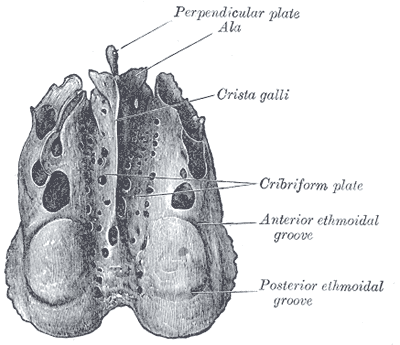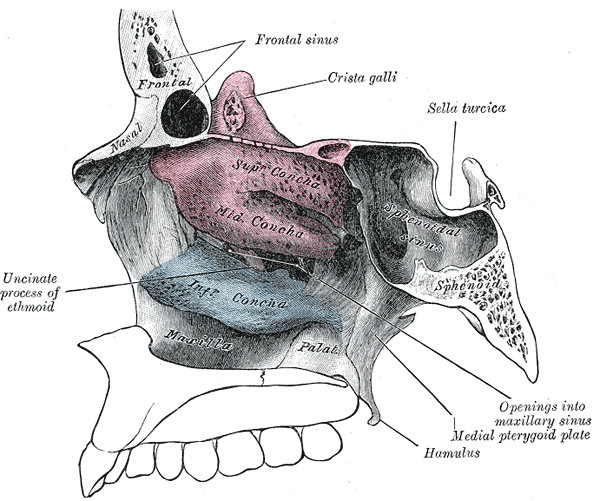Ethmoid bone
|
|
The ethmoid bone (os ethmoidale) is a bone in the skull that separates the nasal cavity from the brain. As such, it is located at the roof of the nose. The cubical bone is lightweight due to a spongy construction. The ethmoid bone consists of four parts:
- the horizontal "cribriform" plate (lamina cribrosa), part of the cranial base
- the vertical "perpendicular" plate (lamina perpendicularis), which is part of the nasal septum
- the two lateral masses (labyrinths)
The ethmoid bone (os ethmoidale) is exceedingly light and spongy, and cubical in shape; it is situated at the anterior part of the base of the cranium, between the two orbits, at the roof of the nose, and contributes to each of these cavities. It consists of four parts: a horizontal or cribriform plate, forming part of the base of the cranium; a perpendicular plate, constituting part of the nasal septum; and two lateral masses or labyrinths.
| Contents |
Cribriform Plate
The cribriform plate (lamina cribrosa; horizontal lamina) [Fig. 1] is received into the ethmoidal notch of the frontal bone and roofs in the nasal cavities. Projecting upward from the middle line of this plate is a thick, smooth, triangular process, the crista galli, so called from its resemblance to a cock's comb. The long thin posterior border of the crista galli serves for the attachment of the falx cerebri. Its anterior border, short and thick, articulates with the frontal bone, and presents two small projecting alæ, which are received into corresponding depressions in the frontal bone and complete the foramen cecum. Its sides are smooth, and sometimes bulging from the presence of a small air sinus in the interior. On either side of the crista galli, the cribriform plate is narrow and deeply grooved; it supports the olfactory bulb and is perforated by foramina for the passage of the olfactory nerves. The foramina in the middle of the groove are small and transmit the nerves to the roof of the nasal cavity; those at the medial and lateral parts of the groove are larger—the former transmit the nerves to the upper part of the nasal septum, the latter those to the superior nasal concha. At the front part of the cribriform plate, on either side of the crista galli, is a small fissure which is occupied by a process of dura mater. Lateral to this fissure is a notch or foramen which transmits the nasociliary nerve; from this notch a groove extends backward to the anterior ethmoidal foramen.
Perpendicular Plate
The perpendicular plate (lamina perpendicularis; vertical plate) [Fig. 2&3] is a thin, flattened lamina, polygonal in form, which descends from the under surface of the cribriform plate, and assists in forming the septum of the nose; it is generally deflected a little to one or other side. The anterior border articulates with the spine of the frontal bone and the crest of the nasal bones. The posterior border articulates by its upper half with the sphenoidal crest, by its lower with the vomer. The inferior border is thicker than the posterior, and serves for the attachment of the septal cartilage of the nose. The surfaces of the plate are smooth, except above, where numerous grooves and canals are seen; these lead from the medial foramina on the cribriform plate and lodge filaments of the olfactory nerves.
Gray151.png
image:Gray151.png
Figure 3 : Ethmoid bone from behind.
Labyrinth
The Labyrinth or Lateral Mass (labyrinthus ethmoidalis) consists of a number of thin-walled cellular cavities, the ethmoidal cells, arranged in three groups, anterior, middle, and posterior, and interposed between two vertical plates of bone; the lateral plate forms part of the orbit, the medial, part of the corresponding nasal cavity. In the disarticulated bone many of these cells are opened into, but when the bones are articulated, they are closed in at every part, except where they open into the nasal cavity.
Surfaces
The upper surface of the labyrinth [Fig. 1] presents a number of half-broken cells, the walls of which are completed, in the articulated skull, by the edges of the ethmoidal notch of the frontal bone. Crossing this surface are two grooves, converted into canals by articulation with the frontal; they are the anterior and posterior ethmoidal canals, and open on the inner wall of the orbit. The posterior surface presents large irregular cellular cavities, which are closed in by articulation with the sphenoidal concha and orbital process of the palatine. The lateral surface [Fig. 4] is formed of a thin, smooth, oblong plate, the lamina papyracea (os planum), which covers in the middle and posterior ethmoidal cells and forms a large part of the medial wall of the orbit; it articulates above with the orbital plate of the frontal bone, below with the maxilla and orbital process of the palatine, in front with the lacrimal, and behind with the sphenoid.
In front of the lamina papyracea are some broken air cells which are overlapped and completed by the lacrimal bone and the frontal process of the maxilla. A curved lamina, the uncinate process, projects downward and backward from this part of the labyrinth; it forms a small part of the medial wall of the maxillary sinus, and articulates with the ethmoidal process of the inferior nasal concha.
The medial surface of the labyrinth [Fig. 5] forms part of the lateral wall of the corresponding nasal cavity. It consists of a thin lamella, which descends from the under surface of the cribriform plate, and ends below in a free, convoluted margin, the middle nasal concha. It is rough, and marked above by numerous grooves, directed nearly vertically downward from the cribriform plate; they lodge branches of the olfactory nerves, which are distributed to the mucous membrane covering the superior nasal concha. The back part of the surface is subdivided by a narrow oblique fissure, the superior meatus of the nose, bounded above by a thin, curved plate, the superior nasal concha; the posterior ethmoidal cells open into this meatus. Below, and in front of the superior meatus, is the convex surface of the middle nasal concha; it extends along the whole length of the medial surface of the labyrinth, and its lower margin is free and thick. The lateral surface of the middle concha is concave, and assists in forming the middle meatus of the nose. The middle ethmoidal cells open into the central part of this meatus, and a sinuous passage, termed the infundibulum, extends upward and forward through the labyrinth and communicates with the anterior ethmoidal cells, and in about 50 per cent. of skulls is continued upward as the frontonasal duct into the frontal sinus.
Gray152.png
image:Gray152.png
Figure 4 : Ethmoid bone from the right side.
Ossification
The ethmoid is ossified in the cartilage of the nasal capsule by three centers: one for the perpendicular plate, and one for each labyrinth. The labyrinths are first developed, ossific granules making their appearance in the region of the lamina papyracea between the fourth and fifth months of fetal life, and extending into the conchæ. At birth, the bone consists of the two labyrinths, which are small and ill-developed. During the first year after birth, the perpendicular plate and crista galli begin to ossify from a single center, and are joined to the labyrinths about the beginning of the second year. The cribriform plate is ossified partly from the perpendicular plate and partly from the labyrinths. The development of the ethmoidal cells begins during fetal life.
Articulations
The ethmoid articulates with fifteen bones: four of the cranium—the frontal, the sphenoid, and the two sphenoidal conchæ; and eleven of the face—the two nasals, two maxillæ, two lacrimals, two palatines, two inferior nasal conchæ, and the vomer.
This article is based on an entry from the 1918 edition of Gray's Anatomy, which is in the public domain. As such, some of the information contained herein may be outdated. Please edit the article if this is the case, and feel free to remove this notice when it is no longer relevant.



